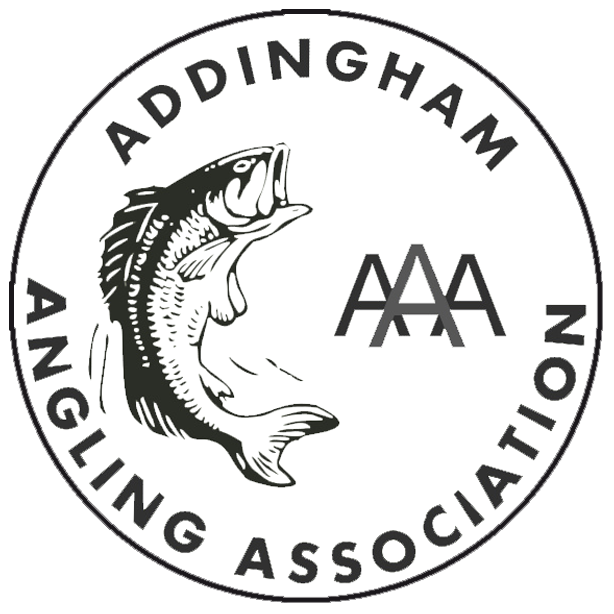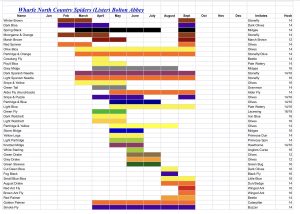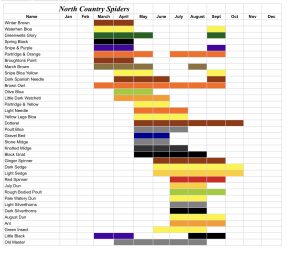North Country Spider Fishing with Steve Cheetham (courtesy of Pete Bell and Dominic Goose)
North Country flies originated for fishing the Dales rivers, as well as a Yorkshire tradition, it is an effective method. On Sunday 21st April 2024, the weather and conditions were ideal, 13 members attended to listen and learn from our expert member, Steve Cheetham. Steve covered the history of North Country flies, tackle and setup, and a demonstration in the river, where he managed to catch a nice trout.
This method is best fished during March-to-June, and Sept-to-Oct. The intention is to fish the top 6” of water. Casting can be upstream, across, or downstream, with about 1.5 rod lengths of fly line. Fish the transitions either side of the fast flow and to cover the water, set yourself ‘a rule’ i.e. 5 casts then take 2 steps forward.
Setup
Longer rods aid fly control – typically 10-12’ 4wt rod (Steve used a 10’ rod).
Typically a standard 9’ monofilament tapered leader cut down from the butt end (thick end) to 4’ to 5’ in length to a 3lb point. (I prefer good old fashioned nylon leaders as opposed to copolymer or fluorocarbon.)
To this add a 3’ (your nose, outstretched arm to tip of finger is about 3’) tippet of 3lb or 2.5lbs. Use a surgeons knot or blood knot to create a dropper. Always use the tag end facing down the leader as the dropper, never the tag end facing up to the rod tip.
Top fly attached on a 2-6” dropper at the end of the leader, then use 3’ lengths ( with an outstretched arm, nose to tip of finger is about 3’) of 3lb (5X) tippet to attach a middle fly on a dropper, and then the point fly.
If fishing with only two flies only cut the leader to 7’ not 4’.
If fishing with only one spider make the leader @ 10’ to 12’ in length.
Degrease the leader with fullers earth to help it sink, don’t forget you are only fishing in the top 6” of waterwhich can be fast fishing.
Casting distance to match the method.
Upstream – cast upstream until the line is about level with you, then recast with the Oval or Belgian Underhand Cast. If you get a fish on when the line is close to you i.e. slack in the line, then roll cast to set the hook.
Across – cast 45o upstream and fish until your line is about 45o downstream. Keep the rod tip high and don’t keep too much line in the water.
Downstream – cast 45o downstream, keep moving the rod tip to follow the flies. It requires regular mending to prevent the flies swinging. At the end of the cast, to induce a take, you can lift the rod tip and lower again.
As an option you could use a straight through leader of mono filament (not tapered) although you may not get the turnover required. (To help turnover put a gold head nymph on the point.)
Use the same measurements as above.
Steve’s Recommended Flies (also see tying session report here)
Snipe & Purple (size 16)
Partridge & Orange (size 14)
Waterhen Bloa (size 14)
Steve’s Top Tips
Create the dropper with a three turn water knot, then tie a single overhand half hitch below the knot to make the dropper perpendicular to the line, and less likely to wrap around the line.
To add a new dropper when it’s got too short, with a new length of tippet create a loop against the line, feed the tag end through 4-5 times, and pull both tag ends (or use a 2mm tippet ring in the line).
Tie your fly to the tippet with a Davy Knot, it prevents ‘pig-tailing’ that a clinch knot can cause.
Suggested materials:
Leeda Leaders
Umpqua Leaders
Bayer Perlon
Stroft Nylon 0.12 dia
Hatch Charts
Which fly to use when, it’s important not to over complicate things, Steve uses the three patterns mentioned above the majority of the time, lots of different patterns will just lead to second guessing yourself!



